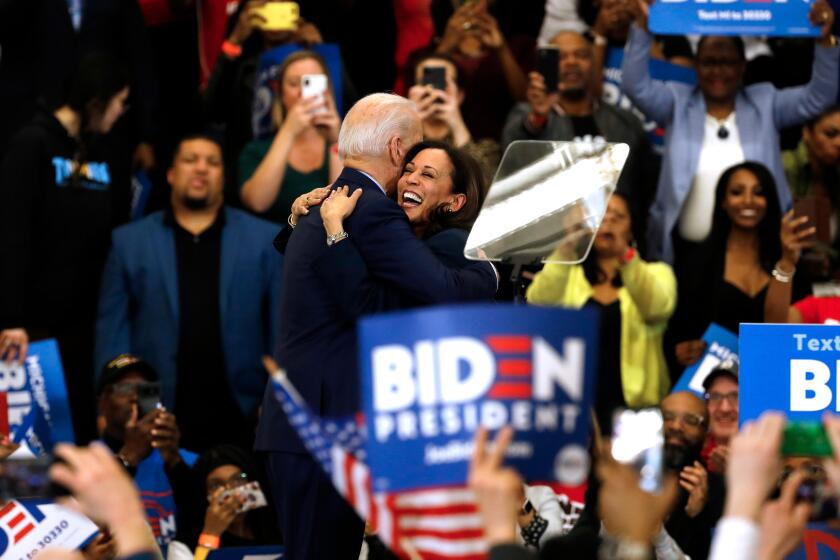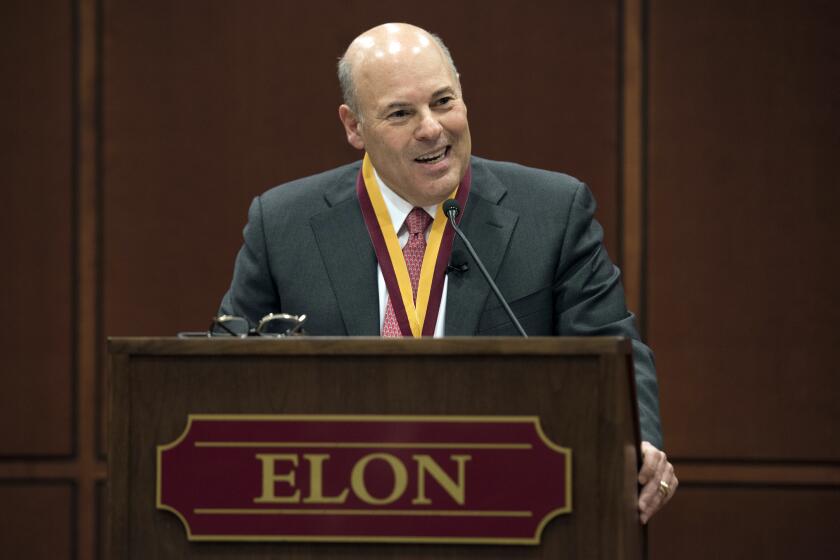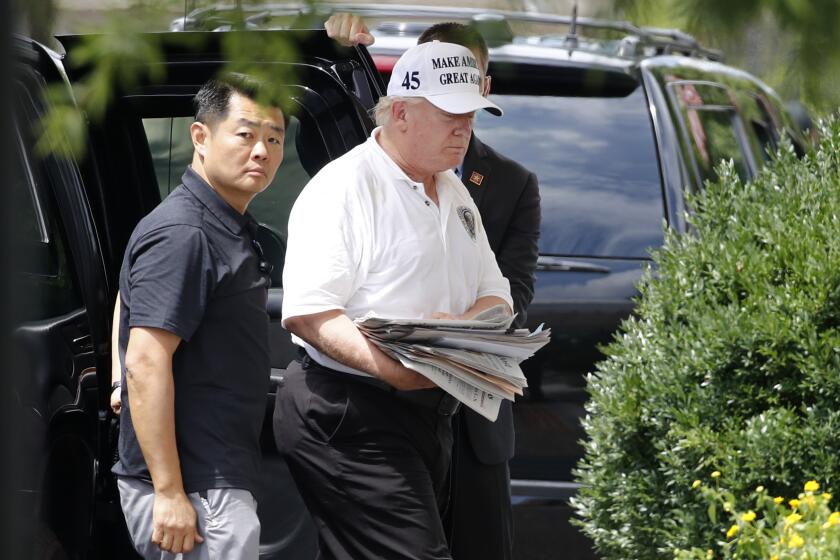How FDR’s vice president warned against the fascism of Trump
- Share via
Philosophers through the ages have remarked on how history moves in circles, not a straight line — that “there is no new thing under the sun,” as Ecclesiastes would have it.
That points us to a warning voiced by Henry A. Wallace, the second of Franklin Roosevelt’s three vice presidents and his first secretary of Agriculture, in 1944.
Wallace’s subject in an essay published in the New York Times on April 9 that year was “the danger of American fascism,” and his warning seems to have come true with uncanny accuracy in the America of Donald Trump.
The American fascists are most easily recognized by their deliberate perversion of truth and fact. ... They claim to be super-patriots, but they would destroy every liberty guaranteed by the Constitution.
— Henry A. Wallace, former vice president, in 1944
Given the time in which he wrote, it’s unsurprising that the topical focus of Wallace’s essay was the rise of fascism in Germany and Italy. But he sought to identify conditions in those countries that posed an analogous danger to ours.
“Always and everywhere,” Wallace wrote, fascists “can be identified by their appeal to prejudice and by the desire to play upon the fears and vanities of different groups in order to gain power. It is no coincidence that the growth of modern tyrants has in every case been heralded by the growth of prejudice.”
Wallace examined the fascists’ manipulation of public debate — their method is to “poison the channels of public information. ... With a fascist the problem is never how best to present the truth to the public but how best to use the news to deceive the public into giving the fascist and his group more money or more power,” he wrote.
“The American fascists are most easily recognized by their deliberate perversion of truth and fact,” he added. “Their newspapers and propaganda carefully cultivate every fissure of disunity. ... They use isolationism as a slogan to conceal their own selfish imperialism. ... They claim to be super-patriots, but they would destroy every liberty guaranteed by the Constitution.”
Could there be any more accurate description of Donald Trump’s political tactics? From the moment he began campaigning through to his very latest utterances on Twitter, Trump has strived to divide the American public, not bring them together in the longer tradition of American political leadership.
A new New Deal would correct America’s 50-year decline and fix the COVID-19 pandemic, too.
He has demonized Mexicans, immigrants and Muslims. He has manipulated the news media — and not only the sycophants of Fox News — to sow disunity, even fostering a political divide over sensible anti-pandemic practices such as mask-wearing and social distancing.
He has dismantled the alliances between the U.S. and Europe that established a lasting postwar peace, and trade agreements with Asian and North American partners that made all parties richer.
He was wrapped himself in the flag as though to claim the mantle of patriotism for himself and his followers. He has dismissed truthful reports of real conditions as “fake news,” while his acolytes defend their lies as “alternative facts.”
None of this is designed to make life better for ordinary Americans, but only to gain and maintain power.
Wallace’s words made centrists extremely uneasy. The New York Times, in the very same edition in which it published Wallace’s essay, denounced it for going too far. “It is astonishing that Mr. Wallace cannot see that in going to such lengths he approaches the very intolerance that he condemns,” the Times editorialized.
Before delving deeper into Wallace’s warning, a few words about the man are in order. In political terms, Wallace rather disappeared into the fringes of the Democratic Party after it replaced him on the presidential ticket in 1944 with the more pacific Harry Truman.
(FDR’s vice president for his first two terms was John Nance “Cactus Jack” Garner, the vinegary Texan House speaker who had run against him for the presidential nomination in 1932.)
Wallace has been gaining more attention in recent years, partially because of his position as a true progressive in a Roosevelt administration that was much less leftist than its popular image.
The latest and most trenchant examination comes from the veteran journalist John Nichols, whose book about Wallace, “The Fight for the Soul of the Democratic Party,” was published in April.
Trump’s attack on the U.S. Postal Service goes beyond vandalism and undermines democracy.
Nichols properly casts Wallace as an evangelist for the moral component of the New Deal. In his campaign in 1943 and 1944 aimed at fending off Democratic Party opponents trying to oust him from the ticket, Nichols observes, Wallace “rallied with African Americans against racism, with Jews against anti-Semitism, with women for an Equal Rights Amendment, with returning soldiers about what the country owed them for their sacrifices.”
Wallace was an Iowan agricultural economist whose father, Henry C. Wallace, was the publisher of an agricultural newsletter who had preceded his son as Agriculture secretary in the Harding and Coolidge administrations.
His incisive analysis of the economic crisis of the farm belt, which had persisted since the end of World War I, was respected, but his prescriptions, which included reducing farm surpluses by plowing crops under and the forced slaughter of hogs, including pregnant sows, was controversial — and caused him, as a member of a farming family, no end of pain.
By 1944, Wallace’s stances against racial discrimination and his perceived friendliness to the Soviet regime produced a strong bloc of Democrats opposed to his renomination as vice president, especially since Roosevelt’s declining health increased the chance that he would rise to the presidency.
Roosevelt kept him near at hand naming him Commerce secretary after his ouster from the ticket, and later continued his progressive campaign and even served as editor of the New Republic, then a progressive publication, from 1946 to 1948.
Wallace ran for president in a quixotic third-party bid in 1948 but was trounced, receiving less than 3% of the popular vote. He died in 1965 at age 77.
Recent rulings from the Trump administration double down on cruel policies related to the coronavirus outbreak.
Wallace’s political legacy lies in his unalloyed support for Democratic ideals, as his 1944 essay shows.
But that didn’t keep him from detecting the potential for homegrown American fascism in the methodology of those foreign regimes as well as the alliances they had formed with big business.
Wallace’s diagnosis of these alliances prefigures one of the outstanding maladies of today’s American economy, too.
“They demand free enterprise,” he wrote, “but are the spokesmen for monopoly and vested interest.” Their goal is to “capture political power so that, using the power of the state and the power of the market simultaneously, they may keep the common man in eternal subjection.”
Wallace was hopeful that the principles of American democracy could keep fascism from coming to power in the U.S. But that would require vigilance.
In a closing line that prefigures spookily the America of today, he wrote that fascism “is an infectious disease.”
For democracy to prevail, he wrote, “it must put human beings first and dollars second. It must appeal to reason and decency and not to violence and deceit.”
But it might be a near thing. Were Wallace alive today, he might conclude that we weren’t paying attention to his words.
More to Read
Inside the business of entertainment
The Wide Shot brings you news, analysis and insights on everything from streaming wars to production — and what it all means for the future.
You may occasionally receive promotional content from the Los Angeles Times.














